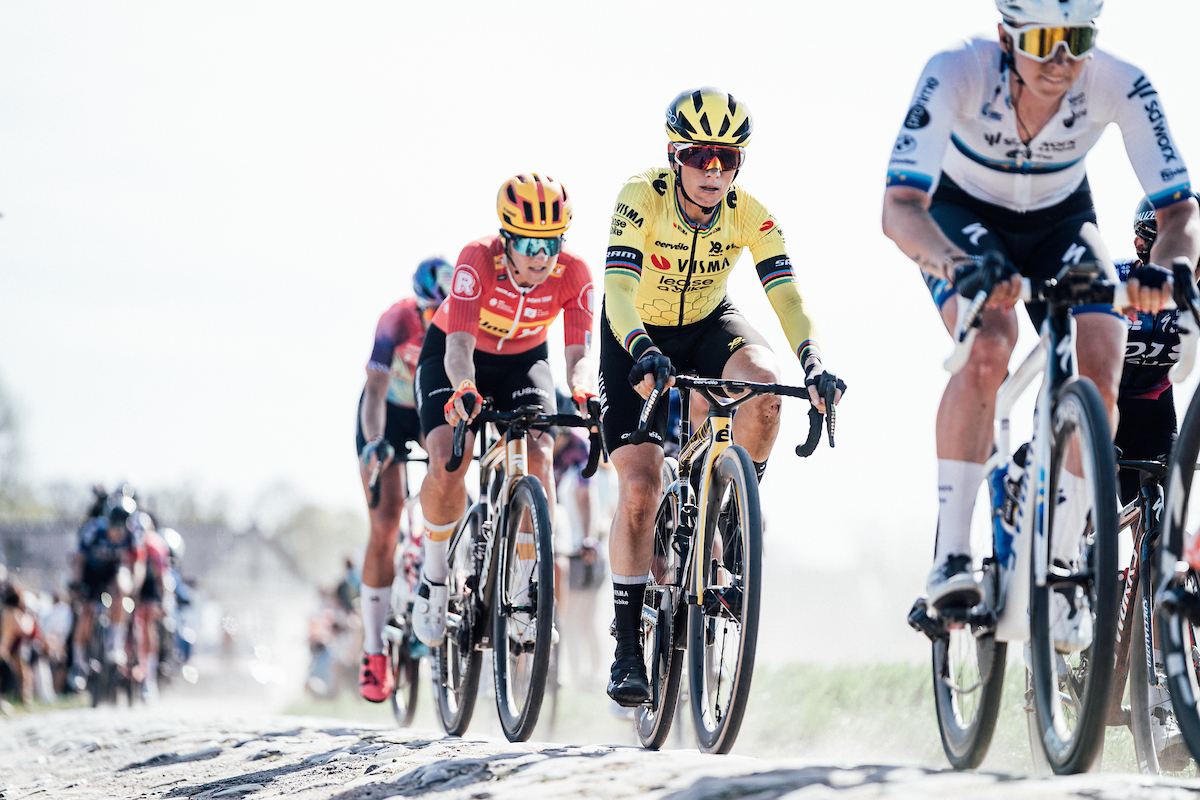More comfortable and more adherence on back wheel – Pauline Ferrand-Prévot embraces adjustable tyre pressure edge at winning Paris-Roubaix debut
Visma-Lease a Bike rider says for Tour of Flanders the self-inflating technology was a 'maybe but maybe not' though 'for the cobbles of Paris-Roubaix there is no question'

Pauline Ferrand-Prévot had already put the Gravaa adjustable tyre pressure system to the test at the Tour of Flanders but the real benefits were felt on Saturday's Paris-Roubaix Femmes where the Visma-Lease a Bike rider made her winning debut.
"We tried it at the Tour of Flanders but the system was 400 grams heavier so I said, 'maybe but maybe not'," Ferrand-Prévot, who came second at last weekend's cobbled Classic, said of the race which included 12 climbs.
"For the cobbles of Paris-Roubaix there is no question because the weight was not super important as it's a flat race. We were very lucky to have this system."
There was never any doubt the French rider already held an advantage on the roughest of terrain, delivered by the notoriously brutal cobbles, given the rider has just switched back to the road from mountain biking where she holds five world titles and Olympic gold.
However, the adjustable tyre pressure system, which various members of the team have tried across a variety of races in recent seasons, added a noticeable edge in the 148.5km race to the Roubaix velodrome.
“For sure it was super good to have lower pressure on the cobbled zones," said Ferrand-Prévot at the post-race media conference. "I could see that we were much more comfortable, with less jumping there was more adherence on the back wheel."
"To be able to pump (up the tyres) again on the tarmac was super good," added Ferrand-Prévot, who made her escape from the leading bunch on the road but then dropped her break companion, Emma Norsgaard (Lidl-Trek), and extended the gap on the cobbles. "There were a few cases where there was quite a lot of tarmac. At the end of the race on the road to finish, I had four bars and that makes a big difference."
The Gravaa system, which Cyclingnews senior tech writer tested on the cobbles of Roubaix this week, is controlled by a pair of wireless buttons, one to deflate and one to inflate. Deflation is a rapid process whereas pressing the inflate button engages a crankshaft in the hub which compresses air and forces it into the tyres, taking around 800m to 1km to gain one bar of pressure.
Ferrand-Prévot said she'd put in a considerable amount of effort in the run up to Saturday's Monument to identify just exactly where she would adjust the pressure to deliver the optimum advantage.
Get The Leadout Newsletter
The latest race content, interviews, features, reviews and expert buying guides, direct to your inbox!
"I needed to study a bit where to have to pressure up and more," Ferrand-Prévot said. "For sure, the last 15km it helped a lot. I had a pressure of four bars in the tyre, while on the cobblestones, I was at 2.1 or 2.2."
It was a constant process of adjusting through the race with 17 cobbled sectors.
"I changed almost every sector. It's super quick when you put less pressure, it's 'phshhh' and goes down," said Ferrand-Prévot. "To go up to four bars takes a few minutes, so you need to be patient."
While Ferrand-Prévot and Marianne Vos – who had already ridden the system to victory at the UCI Gravel World Championships in 2024 – were utilising the technology at Flanders the men's team didn't have it on board last weekend. That, however, is expected to change at Paris-Roubaix this Sunday, with Wout van Aert seen using it on his final reconnaissance ride.
The question now is whether he can deploy it just as effectively as Ferrand-Prévot did to help deliver a winning outcome for Visma-Lease a Bike on the 30 cobbled sectors of Sunday's 259.2km men's race too.

Simone is a degree-qualified journalist that has accumulated decades of wide-ranging experience while working across a variety of leading media organisations. She joined Cyclingnews as a Production Editor at the start of the 2021 season and has now moved into the role of Australia Editor. Previously she worked as a freelance writer, Australian Editor at Ella CyclingTips and as a correspondent for Reuters and Bloomberg. Cycling was initially purely a leisure pursuit for Simone, who started out as a business journalist, but in 2015 her career focus also shifted to the sport.
- Stephen FarrandHead of News
You must confirm your public display name before commenting
Please logout and then login again, you will then be prompted to enter your display name.